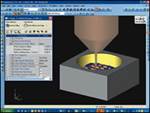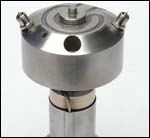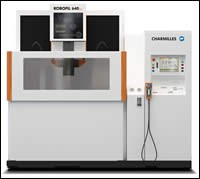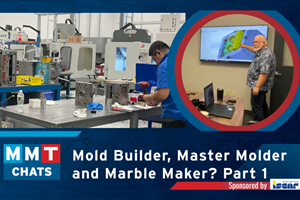Medical: The Right Rx for American Tool Builders
When technology, quality and speed step to the fore in the medical world, so does the North American mold and die industry with some innovative products and processes.
Top-tier American moldmakers are aggressively investing in new technology and even stretching the bounds of imagination to take advantage of bur-geoning high-value opportunities and enormous challenges in the medical market.
The rules in medical moldmaking are significantly different, giving domestic builders an advantage over offshore sources. Quality, of course, is absolute. Volumes are often much lower. Polymer prices are a major issue and even range into the thousands of dollars a pound for the rapidly growing bioabsorbable and other sophisticated materials used for implants, including drug-eluting compounds. Technology is being stretched to the limits in every aspect from wire EDMing for micro tool components to sophisticated new hot runner approaches.
High-end mold builders love the challenge. The old business paradigm of “molds on wheels” chasing the lowest purchase order is not the name of the game in medical.
“We have invested over three million dollars in the last couple of years. These investments support our customer’s needs in the medical market,” says Nick Schommer, director of tooling services at Phillips Plastics in Hudson, WI. “All three of our mold manufacturing locations now have a high-speed machining cell, with capabilities up to 42,000 rpm. The oldest machine is less than three years old, and we are planning to buy at least two more machines.”
Recent equipment purchases at Phillips Plastics include: three Roeders RFM 600 high-speed machining centers, two Mazak Nexus 510 machining centers, one Haas VF3SS, three new Charmilles sinker EDMs, two Charmilles wire EDMs and three System3R robotic systems.
Technology Investment
Machining Challenges
“In the medical mold and die industry, customers face even more challenges than in a typical environment due to the incredibly small sizes and the high precision that is required,” comments Jay Verellen, product manager for Seco-Carboloy (Warren, MI). “That is key—high precision—smaller items with tighter tolerances and better surface finish. Even though everything is smaller in this industry, in a way everything is exaggerated—the ratios can be extreme—you might be using a 2-mm diameter tool that is 30 mm in length, a 15:1 length to diameter ratio.”
Verellen strongly recommends looking at the overall system in the high-speed machining prevalent in medical, not just the tool or insert. “Good balance is where it all begins,” he comments. The Seco EPB line, for example, uses solid carbide end mills in applications where precision and high speeds are important, such as medical.
Component Offerings
Another product that meets demanding requirements in the medical market are the new needle bearing locks from Progressive Components (Wauconda, IL) that provide precise registration between the two halves of the tool. As the locks engage, the bearings provide additional lifting power without metal-to-metal wear, says Mark Malloy, sales and marketing manager at Progressive.
EDM Enhancements
EDM machinery manufacturers are dramatically upgrading product offerings for the medical moldmaking market.
Mitsubishi EDM (Wood Dale, IL) last year unveiled the MD+PRO, which features a PM4 control that enables full automation from rough to finish machining. Stepped shape capabilities allow machining of multiple parts with different shapes and thicknesses without setting specific electrical conditions. The new machine comes standard with 0.006-in to 0.012-in wire capable automatic threading and all-axis absolute control, allowing very accurate positioning without returning to zero after power failure.
Charmilles (Lincolnshire, IL) is targeting technology innovation in the medical market on the wire side of the business. “Our new CC generator provides very high cutting speeds and clean surface finishes because medical users want an absolute minimum of deposits on the final workpiece,” comments Gisbert Ledvon, marketing manager for Charmilles. The CC generator is a digital generator that features a new spark design, increasing maximum voltage by 25 percent and tripling maximum amplitude to 1,200 amps. Cutting speed in tool steel can reach a high of 42 square inches an hour. The previous top speed was about 37 square inches an hour. The CC generator prevents oxidation on the titanium parts often used for hip and other implants. It also maintains a surface integrity that is free of brass and zinc materials that can come from the electrode during the cutting process.
Hot Runner Advancements
Another example of a technology innovation aimed at the medical market is the Melt-Disk from Mold-Masters Limited (Georgetown, Ontario), which allows side-gating into parts such as syringe barrels where top gating is not possible. “There are two primary benefits,” says Denis Babin, product development manager at Mold-Masters. “The first is that you are able to side gate with a hot tip. I always mention the hot tip because you can edge gate, but you end up with a cold slug riding in the part. The second benefit is that you are getting multiple gates (up to eight) with one Melt-Disk. You can mold the same number of parts with fewer nozzles.”
Mold-Masters already has about a dozen applications for the Melt-Disk, some of them in the beta stage. All nozzle lengths are available for the Melt-Disk, 28–148 mm. A wide range of materials, from polyethylene to polycarbonate, is being used and Mold-Masters is testing use of glass-filled compounds now. Individual heat control in the gate area opened up the materials’ range dramatically with the Melt-Disk. Thermal profile across the Disk is excellent, probably within 3°C from tip to tip, says Babin.
Applying Technology
The View at Mayo
Biomedical engineers are very focused on product features and quality and are less driven by volume and cost considerations due to the applications of their designs.
Providing some insight on how their market works is Steven R. Jurrens, super-visor of the Biomechanical Development Unit-Machine Shop in the Division of Engineering at one of the world’s greatest medical innovation incubators, the Mayo Clinic in Rochester, MN.
“We’re an internal captive engineering group,” comments Jurrens. “Our charge is to work with staff, physicians and researchers to invent, design, develop and fabricate those items needed by Mayo, which do not currently exist on the open market.”
The Division of Engineering staff numbers 52, among a total of 30,000 Mayo Clinic employees at Rochester. The Division handles some 1,300 requests annually, with the machine shop having an active queue of 200+ projects at any point in time. “We do a lot of custom development, even custom surgical instruments,” says Jurrens. The Biomechanical Development Unit staff includes two managers, four mechanical engineers, two mechanical designers and 13 CNC machinists.
One recent request came to the Division from Mayo’s Medical Laboratories group. This department processes millions of medical samples a year for testing. “Medical lab personnel have to re-tube certain incoming samples due to existing container design and shipping issues,” Jurrens told MoldMaking Technology. “They approached us to develop a new type of tube cap to increase overall efficiency of the testing process and reduce the internal cost of operations.”
The Division designed the new tube cap in SolidWorks and machined the first batch of prototype parts. Successful validation testing led to approval to proceed with tooling. First-article testing is currently underway on the first core and cavity set of a 16-cavity tool. Upon final validation, Mayo will be using 250,000 parts per quarter. The new tube cap will solve existing process problems, improve efficiency and expand Mayo’s abilities for certain types of medical testing.
The Division must maintain its “cutting edge” approach to design, fabrication and technology, applying newer techniques such as laser machining and water jet cutting with classic technologies of milling and turning.
Medical Trends
Micro Is Getting BIG
One of the new breakthrough areas in medical moldmaking is micro molding, which requires tremendous technology advances in tool construction and design.
A global innovator is Miniature Tool and Die in Charlton, MA, whose business is about 90 percent medical because of the mushrooming use of tiny devices that traverse blood vessels for noninvasive surgery. Also, extremely tiny new screws are being made of pricey bioresorbable materials for holding tissue in place.
“Micro molding is very different from conventional molding,” comments Donna Bibber, a plastics engineer who is vice president of sales for MTD. “Material is going through gates that are 0.002- to 0.005-in and that is very different from going through gates that are 0.020 or 0.030-in. As a result of that, the viscosity from shear changes all of the rules of everything you once knew about molding.”
MTD has even developed its own mold flow analysis to map changes in the material caused by the intense pressure and shear heat in the micro process. MTD also built its own proprietary drying apparatus because hoppers are about test tube in size.
“Everywhere we turn, there seems to be a new challenge to overcome,” comments Bibber. “For example, we don’t always have the luxury of having a surface to eject onto. Ejection usually occurs on a gate or runner or some other external appendage to the part. Parts are so small that they tend to be edge gated. It’s a whole art form just to get the gate off cleanly. When the parts go into the human body, there can’t be any jagged edges.” MTD often uses high-end fixtures to hold tiny knives or wires or other types of secondary equipment. MTD uses both types of EDM to make the molds, but can’t divulge any details.
One of the biggest issues with micro is just defining it. “We define micro as a part that has a volume of less than 0.003 cubic inches,” comments Tony Pelke, an engineer at Phillips Plastics, which is unique in its ability to produce tooling for metal and plastic micro applications. “They’re parts in which you need magnification to see features or details.” One of its parts has a diameter of about 0.008 in.
The cost of single-cavity micro tools at Phillips Plastics is in the approximate range of $8,000 to $20,000. The company does not sell micro tools to OEM customers. It quotes a nonrecurring engineering charge and keeps the tools at its metal injection molding facility in Menomonee, WI. Phillips has developed its own proprietary process for making micro tools and says “the runner is virtually nonexistent” in its process. Its definition of a micro part (volumes under 0.0003 cubic inches) includes the runner. The waste issue is significant because no regrind can be used in medical applications and implantable materials can cost $2,000 to $4,000.
Turnaround time for micro tooling at Phillips is two to four weeks for plastics and four to six weeks for metal applications. Phillips can achieve tolerances of ±0.050-in on micro plastic parts, but cautions that measurement is one of the huge obstacles in micro molding. MTD’s Bibber agrees on the measurement point. “When you’re talking about tolerances of 0.0001" on plastic parts, there is more error in measurement than there is in the molded part, which is very repeatable,’ says Bibber. “When we talk to customers in the proposal stage, we always talk to them about how we will measure the parts and how they will measure them.” MTD typically uses vision systems and microscopes that magnify to 600X to measure surfaces and tolerances.
While the parts in medical are getting tiny, the efforts by moldmakers and their suppliers are not.
Related Content
Dynamic Tool Corporation – Creating the Team to Move Moldmaking Into the Future
For 40+ years, Dynamic Tool Corp. has offered precision tooling, emphasizing education, mentoring and innovation. The company is committed to excellence, integrity, safety and customer service, as well as inspiring growth and quality in manufacturing.
Read MoreMantle TrueShape Advances Medical Mold Manufacture
In a recent case study, Mantle’s 3D-printed inserts enabled a medical device manufacturer to reduce 12-week lead times for prototype mold production to 4 weeks and at one-third of the cost.
Read MoreLessons in Quality Assurance for Micro Projects
Quality control, quality assurance and measurement technology are central considerations for micro mold building and molding.
Read MoreMMT Chats: Mold Builder, Master Molder and Marble Maker? Part 1
MoldMaking Technology Editorial Director Christina Fuges introduces new MMT Editorial Advisory Board Member Mike Close, Sr. Tooling Engineer for SMC Ltd. in Devens, Massachusetts. This episode is brought to you by ISCAR with New Ideas for Machining Intelligently.
Read MoreRead Next
Opportunities for Mold Shops with Micro Molds and Micro Milling
Learning about the trends and challenges with micro molds and micro milling will help shops maintain their competitive edge.
Read MoreHow to Use Strategic Planning Tools, Data to Manage the Human Side of Business
Q&A with Marion Wells, MMT EAB member and founder of Human Asset Management.
Read More




















